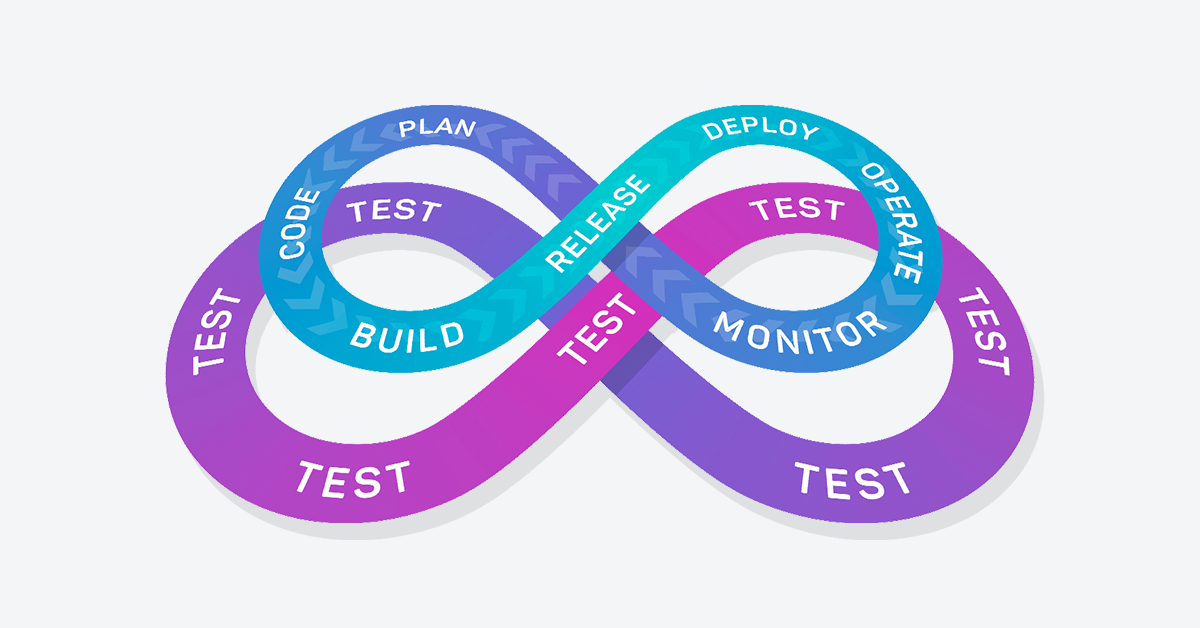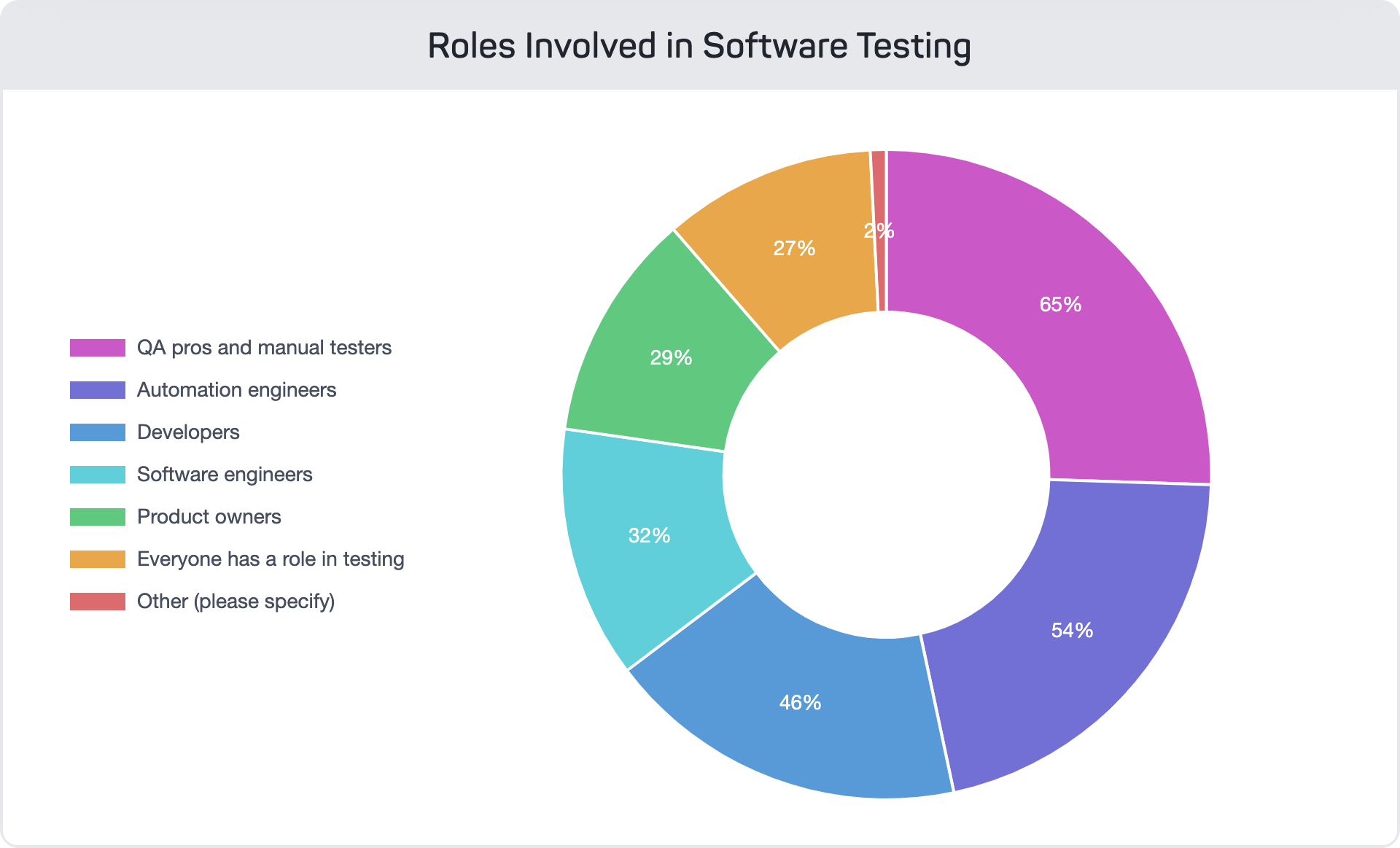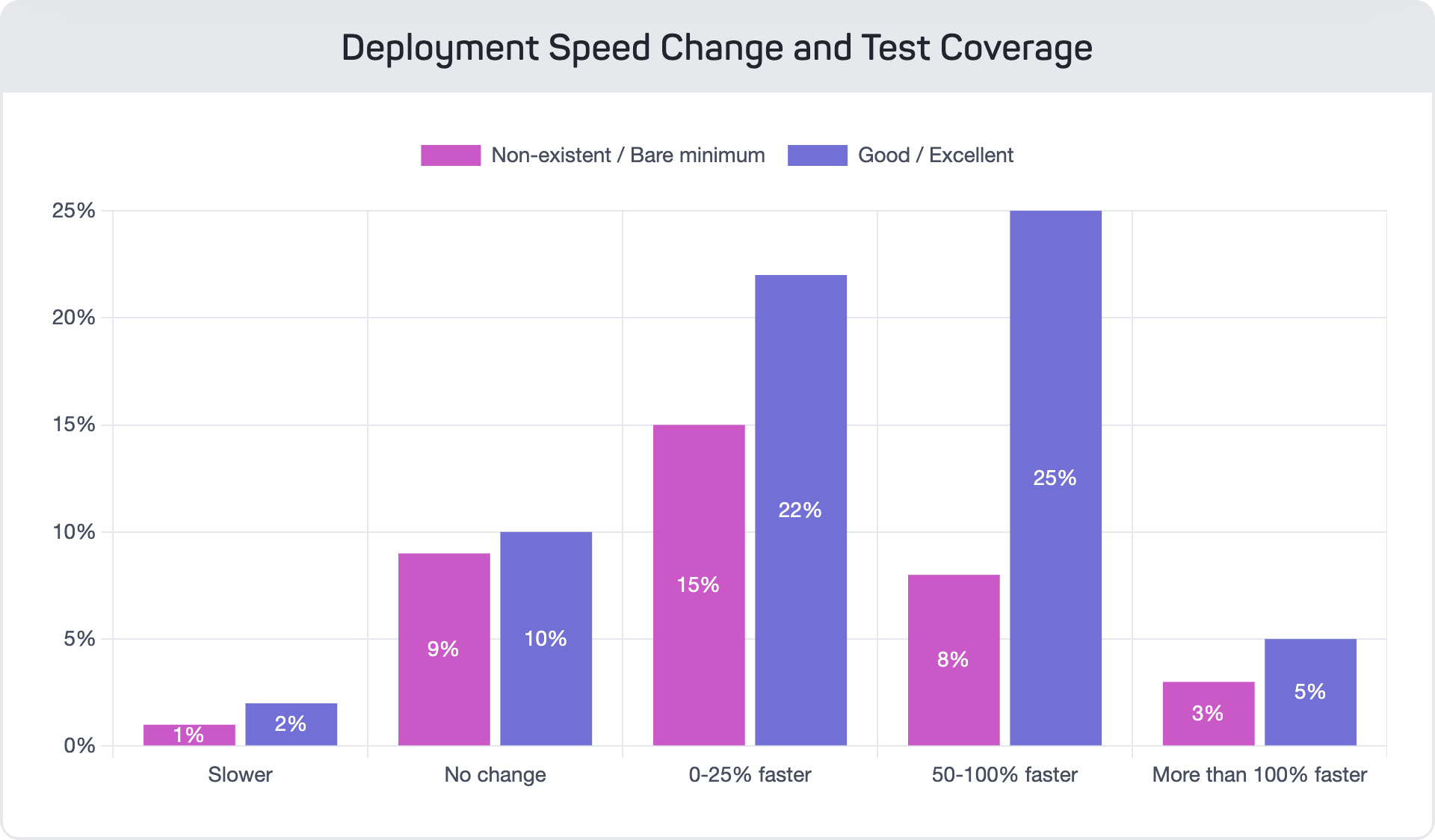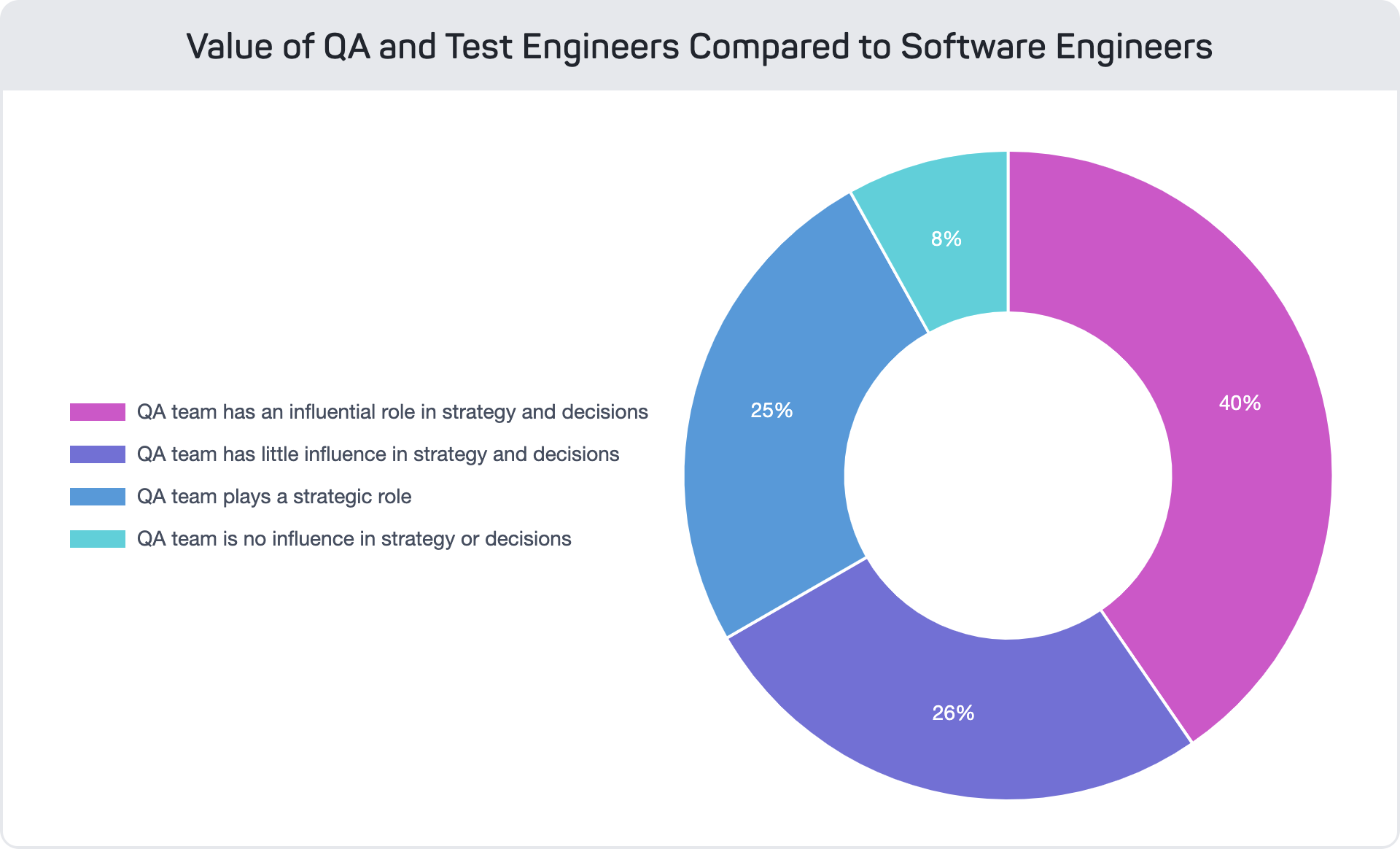The Three Critical Elements of a Culture of Quality
We define a strong culture of quality as one where team members, including developers, QA, and business stakeholders contribute to the creation, execution, and maintenance of tests across the development pipeline. This is a culture where the team understands the importance of quality, and actively works to contribute to processes and activities that optimize application quality.
The impact of a great culture of quality? |
|
|
More
|
Less
|
The foundations of a strong culture of quality are people, processes, and technology.
People: Consider the role each team member (in and outside the QA organization) plays in software quality, and how they collaborate with each other.
Processes: Assess the processes you have in place for testing activities, oversight, and collaboration.
Technology: What systems or software does your organization have that enable good testing practices?
Quality engineering teams should explore each of these culture pillars to understand where their teams are mature, or where there’s an opportunity for improvement. The following sections will help you assess your current organization and build a plan to optimize your QA practices.
People: How to Break Down Silos and Build Careers to Support Your Culture
Team members who are collaborative, understand their role in testing activities, and feel they have learning opportunities will have the greatest impact on quality.
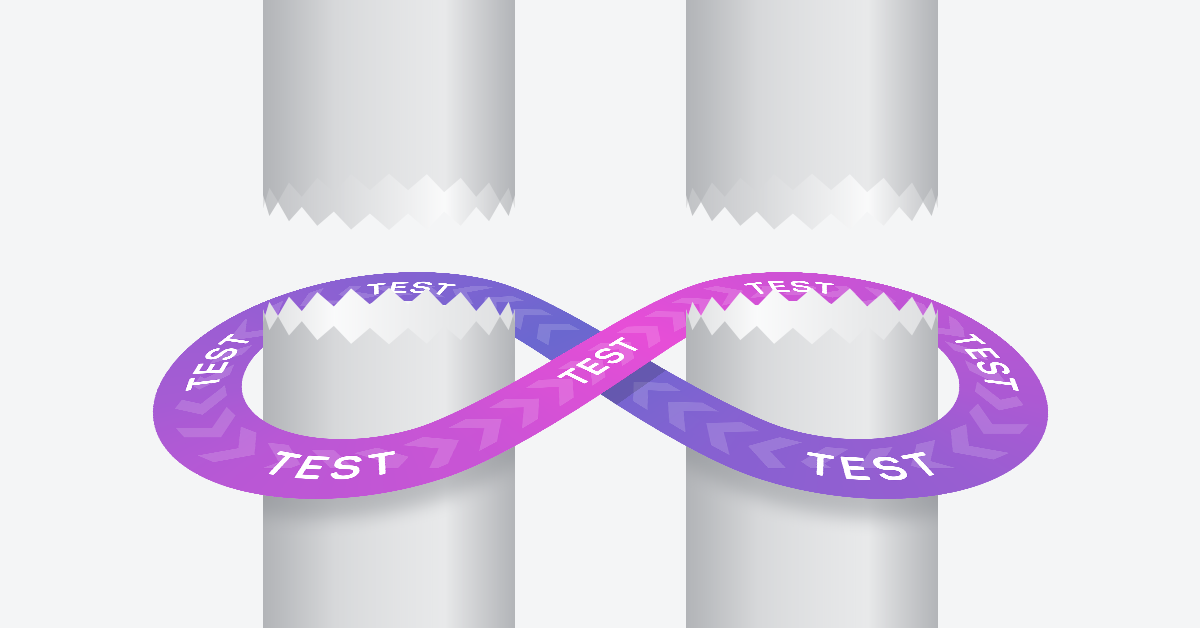
Breaking Down Silos
To truly embed quality into the development pipeline and culture, QA teams need to make their case to leadership. Many top-level stakeholders have goals that are closely tied to quality, such as time-to-delivery for new features, the number of customer complaints, and even company revenue growth. With the right metrics, QA can make a powerful case directly to these leaders and give quality a bigger seat in development planning, even if their current practices are heavily siloed.
Consider how your team can gather data that demonstrates the impact of testing on overall organization goals, then start identifying ways to make your case. Many QA teams find success in running small pilot projects specifically designed to help establish best practices for testing and quality. For example, if an organization is consistently delivering new features behind schedule, QA can partner with an engineering team to shift testing to the left for a single feature, then compare how quickly the new product was delivered, how much time was spent on reworking defective code, and how many bugs were shipped to production. By piloting new ways of working on a small scale, QA teams can build a more comprehensive (and more compelling) understanding of what testing and quality engineering practices that make an impact on high-priority issues that matter to leadership.
Everyone benefits from increased quality activities:
|
When working with individuals on the development and product teams, it’s essential to speak their language. Building an understanding of the pain each role might feel from a lack of attention to quality will help you identify opportunities to expand testing and quality impact.
Enabling Team Members to Grow Professionally
Participating in testing activities provide opportunities for folks across software functions to grow in their careers.
Let’s look at opportunities across software development roles:
- With the availability of low-code test automation solutions, manual testers, who have a unique understanding of how testing impacts the user experience, can start automating manual test cases that augment manual testing efforts and participate in more exploratory testing.
- Automation engineers have the opportunity to advise developers or product owners on how and when to automate tests in the pipeline or start contributing to automating testing for new features.
- To build a culture of quality, developers can improve their coding skills by getting fast feedback on their code before merging code. Low-code solutions also make it faster to build end-to-end tests, which bring developers closer to the user experience and make it easier for them to participate in testing.
- As issues are identified, or new features ship, product owners or business stakeholders can start to contribute to building tests and monitoring quality metrics. By having more team members involved in testing, everyone will feel the responsibility of building quality software.
These activities can help you build a culture of quality across your team.
|
The goal of building a culture of quality is to maximize the impact of QA by elevating testing as an integral part of building good software and establishing better development practices. QA can serve as a center of excellence for quality while building a culture that everyone contributes to.

Case Study: Aligning with Company KPIs
SmugMug wanted to deploy any time, all the time. But doing so meant adopting a new testing strategy that involved their entire engineering organization.
Challenge: Manual testing limited the impact of testing across SmugMug’s highly dynamic customer experiences, hindering efforts to expand testing and potentially introducing user-facing bugs as deployments accelerated.
Solution: Connecting testing to reduced customer support tickets enabled the QA team to showcase their value to leadership. SmugMug understands that they are fundamental to the livelihoods of their customers, especially professional photographers who have built virtual showrooms on the platform. By connecting testing to user experience metrics, QA was able to build buy-in around a culture of quality.
Processes: Set Your Team Up for Success
The slow pace of change was ranked as the top DevOps obstacle for the second year in a row in the 2022 Testing in DevOps Report. Other cultural concerns, such as a lack of leadership or internal politics, dominate the most common issues companies face when improving their development practices. Effective processes that promote communication, optimize workflows, and boost confidence are critical to sustainably and scalably overcoming these challenges and creating a culture of quality.
Processes are the nuts and bolts of a larger cultural change
To ensure that their quality transformation sticks, QA leaders need to clearly define testing processes on their teams. These processes should support your broader goals, such as enabling product velocity or improving the user experience. Some questions that effective processes answer:
- What tests are required when merging or shipping code?
- Who will build those tests, and who will execute and monitor the results of the tests?
- Are different people responsible for testing at different stages of the pipeline? In the testing pyramid?
- Who will manage the regression suite and monitor results?
- What happens when a bug is identified?
- What are the SLAs for resolving bugs at each severity level?
- What is being tested? What is the best way to document test cases?
Creating a shared understanding of quality
QA should evolve into quality coaches as your team’s quality engineering practices mature. To do so, the team needs to be able to communicate process changes effectively - and see that change through to ensure that it’s adopted by the wider organization.
First, many QA leaders have had success testing process changes with 1-2 team members, or a single team. Gaining buy-in from an engaged developer or business stakeholder can help you understand how process changes affect their workflows and give you time to gather feedback before rolling out changes to the broader team or teams.
Second, you’ll need to serve as the leader of your new processes and roll them out to your team. People learn in different ways. Consider documenting the process (literally, write it down), but take time to demo it in a team setting, create a video or checklist, or host a lunch and learn. Try teaching team members in different ways to see what best resonates.
Create a feedback loop that fosters collaboration and communication
As you roll out changes and get more people involved in testing activities, the next step is building a continuous feedback loop.Though every team is different, real-world QA teams from startups to global enterprises have found successes with these tactics:
- Prioritize testing activities in sprints: When testing is visible from the earliest stages of development, everyone has a better understanding of how testing can accelerate delivery cycles and improve product quality.
- Create internal training programs: This equips team members with the knowledge and motivation to pursue common goals that prioritize the CX throughout the SDLC.
- Offer QA office hours: Giving developers and product owners dedicated time to improve their testing knowledge builds buy-in for quality engineering. Allow team members to seek out collaborative time for learning and knowledge sharing.
- Create shared Slack/Teams channels: Shared internal communication channels make it easy for team members to stay informed on test results, current testing activities, and any questions that arise.
- Host friendly competitions: Take gamification to the next level by hosting competitions that foster collaboration and introduce new ways to learn testing tools. Who can create the best tests? Or, who can create X number of tests in X amount of time? Contests are a great way to get team members engaged without the pressure of catching bugs mid-sprint.
- Bug hunting sessions: Similarly, bug hunts help team members explore how different issues can be caught by different testing strategies. The goal is to find as many bugs as you can - what tests will reign supreme? Your team will see how they can make their own QA practice more effective and build stronger relationships with this fun, informative activity.
A culture of quality spans collaboration, testing, product improvements, and reporting. To help team members across the SDLC confidently contribute to product quality, QA needs to lead activities that allow for learning and communication. The process of change may be slow, but shared activities can help teams sustain momentum as they grow their quality engineering practice.
Case Study: Building Processes
Tokio Marine, a leading insurance company in Japan, needed to evolve their software testing strategy as their organization embraced agile and DevOps.
Challenge: As development cycles accelerated, the Tokio Marine team discovered that bottlenecks caused by a mostly manual software testing process were slowing the entire team. They needed processes that matched the collaborative nature of DevOps.
Solution: An automated testing platform that enables developers and testers to collaborate on software testing. Tokio Marine started rolling out their new testing processes by engaging a small group of early adopters who identified best practices and led hands-on learning sessions to encourage cross-functional collaboration.
“Mabl has a dashboard where you can quickly find test results, and the logs and screenshots of test runs make it easy and very convenient to refer to past results. As we scale automated testing across the organization, these features are becoming even more useful. The time spent on QA and quality improvement is being reduced, allowing developers to focus on tasks that are more directly linked to creating value for our customers, such as delivering new features.”
By building its new software testing strategy around collaboration, Tokio Marine is seeing more value from automated testing and enabling their DevOps transformation.
Technology: Enabling Your People and Processes
The Testing in DevOps Report found that 72% of development professionals aren’t hindered by technological capabilities on their DevOps journey. But your toolstack is critical to building effective processes and enabling your team. Once your team and processes are determined, you should audit your existing toolset or techstack to understand if it enables or hinders your teams’ ability to collaborate on quality.
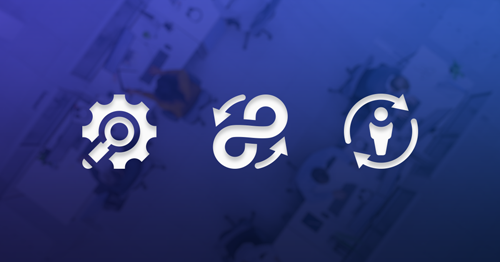
To determine whether you have the right quality engineering tools, here are some important questions to ask:
- Are team members working with disparate tools?
- Is there a unified platform that everyone can leverage?
- Are current tools easily accessible, yet secure?
- Do these tools integrate or speak to one another?
- Can they automate routine tasks?
- Can data be extracted from these tools to make informed, data-driven decisions?
Ultimately, your techstack should provide access to everyone on the team to prevent silos, be easy-to-use for team members with varying degrees of experience, and enable communication and collaboration among team members.
A traditional QA techstack includes software for:
|
If you find that your current technology hinders the team’s ability to build a culture of quality, start building a requirements document. You’ll want to document the capabilities, integrations, and licensing needs of a new tool before you start researching vendors. Once you’ve narrowed your search down to a handful of vendors that meet your requirements, run POCs (proof of concepts) with each candidate. Gather feedback from your team, and ensure the vendor can support your long-term quality goals.
As you adopt new technologies, take a similar approach to rolling out new processes. Test implementations with one team member or a single team, build a feedback loop, and slowly roll out the technology to the broader team.
Case Study: Adopting New Test Automation Software
Stack Overflow improved quality collaboration across QA and development teams with test automation software that made sharing information easier.
Challenge: As a small team responsible for maintaining a 13-year-old codebase and building out a new product, Stack Overflow needed a testing solution that enabled their developers to continuously improve quality without wasting valuable engineering hours.
Solution: A test automation platform that supported more efficient collaboration processes. Software Engineer Meredith Hatzenbeuhler explained:
“I've been surprised by how much value we've gotten out of things like screenshots, test steps, network information, the DOM, et cetera. That’s helped us collaborate with other teams. For example, if an SRE needs to step in, I can simply give them mabl credentials so they can log in, and look at the test. And they’ll have exactly what they need. Whereas before, there would probably be back and forth discussions since we wouldn’t always have such a detailed record with other types of automated testing. That loop of solving problems has definitely become much more efficient.”
A tool designed for collaboration enhanced how Stack Overflow can respond to failed tests, enhancing their culture of quality and accelerating development cycles.
Adopting and Scaling a Culture of Quality Transformation
Once the core pillars of people, process, and technology are in place, it’s time to start adopting and planning the journey to a culture of quality. Remember, a true transformation won’t happen in a day, and many people will need time to adapt to the new ways of working. Janet Bracewell, Senior Engineering Manager, QA at SmugMug shared some practical advice for maintaining momentum on the quality journey:
“It's going to be bumpy. It just will be. Start small, pick one thing, like a section of code or an area of your platform, and begin building your quality strategy around that. Let the developers see that success so they can come to you already invested in quality transformation. If you gain some of that buy-in, then you can lead them by the hand and provide extra support. Always take your whole team along with you.”
Janet Bracewell, Senior Engineering Manager, QA @ SmugMug
In order to build internal investment in a culture of quality, it helps to establish quick, simple ways for those outside QA to get involved. Many teams begin with automated end-to-end tests that run in the background every time developers hit “control + s.” This makes headless UI testing an automatic function whenever a developer saves their work, making it easy to start shifting testing to the left and building a culture of quality.
Establishing a baseline for quality through expanded automated testing also enables quality teams to measure and share progress along the quality journey. Even small gains, such as increasing test coverage by a few percentage points, can make a significant impact as more bugs are caught in pre-production. Using technology to enable and document change helps keep people invested and processes standardized. Though your team may not be ready for fully integrated testing across the SLDC yet, begin establishing processes and solutions that can scale with your goals.
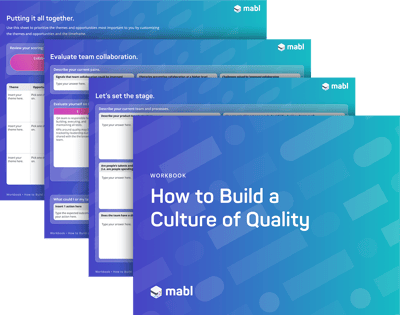
Here is a workbook designed to help you evaluate your current quality tools and processes as you set the stage for transformation. Use it as a practical guide to help establish goals and timelines that will enable your team to innovate faster and with confidence.
About mabl
mabl is the leading intelligent, low-code test automation solution built for teams who are building a culture of quality. It’s the only SaaS solution that makes it easy for anyone to contribute to test automation, and tightly integrate those tests into the development lifecycle. mabl’s unified platform makes creating, executing, and maintaining reliable browser, API, accessibility, and mobile web tests easier than ever.
By combining human and machine intelligence, users are more confident in test execution and can identify and resolve bugs long before they reach production. That’s why customer-centric brands like Charles Schwab, jetBlue, Dollar Shave Club, Stack Overflow, and many others rely on mabl to create the digital experiences their customers demand.

